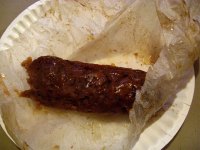
For Yom Kippur, I don’t have a “traditional meal” which I serve every year. Usually I make some sort of chicken or meat dish before the fast, and to break the fast, usually I have soup and a light chicken dish. The only real tradition we have is that I’m finishing the cooking minutes before the sun sets, and J. and I pretend the sky is still light… I was determined to break that tradition this year! I made cholent (recipe made at Peasach) because it is made ahead, and when it is “done” can be varied.
Cholent is a dish usually served as the Sabbath meal. No work is allowed on the Sabbath, so the question is, how to serve a hot dish when cooking and heating are not allowed. The solution is cholent! It has different names around the world, but is essentially a slow-cooked stew of meat, legumes, and grains. Many kinds of dumplings and puddings are added to stretch the meat; depending on the culture, they are made with wheat, couscous, nuts, ground meats, and a variety of spices.
From Cholent (Hamin) – The Ultimate Shabbat Food
❝There is no doubt that the most popular addition is a pudding made in a beef casing (Derma) or stomach – the Jewish Haggis. In the East it is usually filled with mincemeat and rice, flavoured with spices. In Central and Eastern Europe the pudding is known as kishke and traditionally stuffed with a mixture of flour, bread crumbs (matzo meal in Pesach), potatoes and raw chopped chicken, goose or duck fat. It is usually flavoured only with salt and pepper although parsley and dill are sometimes added. The same pudding is made from the neck skin of chickens, duck or geese, in which case it is known as Helzel (neck in Yiddish).
The inclusion of eggs, which is also mentioned in the Mishna, is essential in Eastern and especially in Mediterranean Hamins. The eggs are supposed to symbolize the continuous mourning for the destruction of the Temple. Symbols apart, they were included to stretch the stew when meat was scarce. The eggs are added raw and cook slowly, absorbing the flavour of the stew and become brown and fragrant with a soft melting texture.❞
This time, I added both eggs and kishke. In the past, I’ve used chicken skin to enclose the “sausage,” but this time I had not frozen enough so I used parchment paper. (I skipped boiling them in water.) It worked surprisingly well!
 Kishke-Stuffed Derma
Kishke-Stuffed Derma
Flour and Onion Sausage for the Cholent
from The Book of Jewish Food
by Claudia Roden
serves 6
page 150
- 1 large onion, grated
- 4 Tablespoons raw chicken fat, grated or finely chopped
- Salt and Pepper
- ¾ cup flour
- 2 Tablespoons matzo meal
- Sausage casing: large beef intestine cut into 3 8-inch lengths
Mix all of the ingredients except the casings. Tie the intestine pieces at one end, stuff them loosely with the mixture, and tie the other end tightly. Prick them with a fork to prevent them from bursting during cooking. Boil the sausages in salted water for 10 minutes, then drain. Simmer with meat in a stew, or cook in boiling salted water for 1 hour, or bake in a dish with a little water and surrounded by potatoes for 1 ½ hours at 350°F (180°C), or until browned. If part of a cholent, lay on top of the other ingredients before cooking. Serve cut in slices.
variation:
Add 1 teaspoon of paprika or ½ teaspoon of allspice
http://www.gemsinisrael.com/shabbat.html
https://1tess.wordpress.com/2009/04/19/cholent—the-jewish-cassoulet/
| ⇐ Previous Post | Next Post ⇒ | |
| Yom Kippur: have an easy fast | Home Cooking |







My Father loved kishke,but I could never really get it down….I like to break the fast with fruit and then with some sallads and bread.Gmar Hatima Tova!
I love kishke, but don’t make it often: definitely sticks to your ribs.